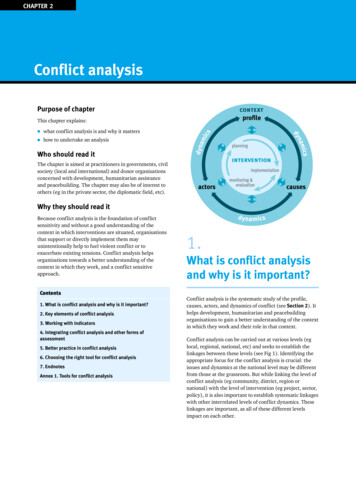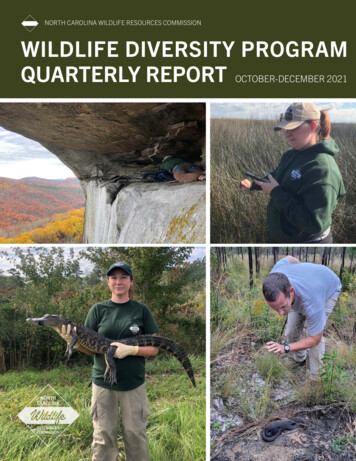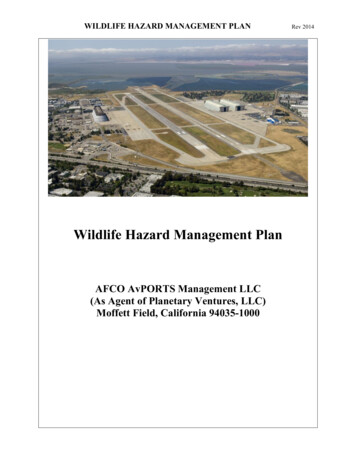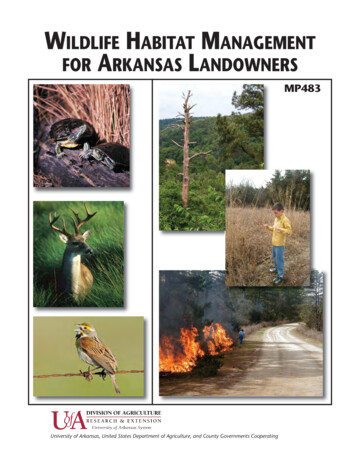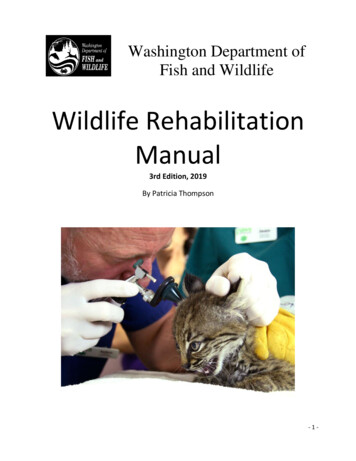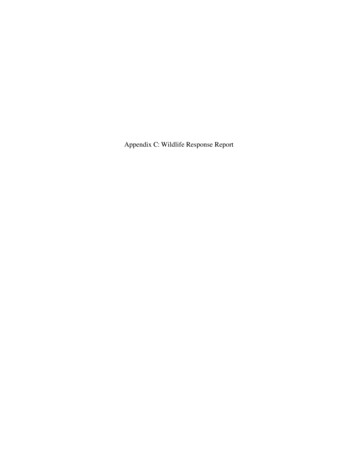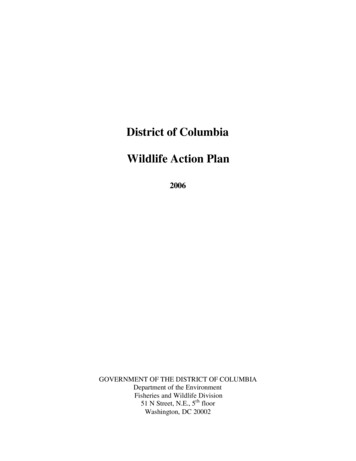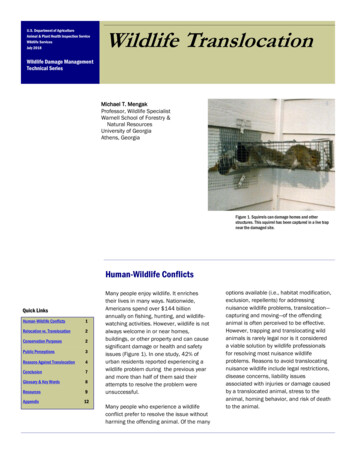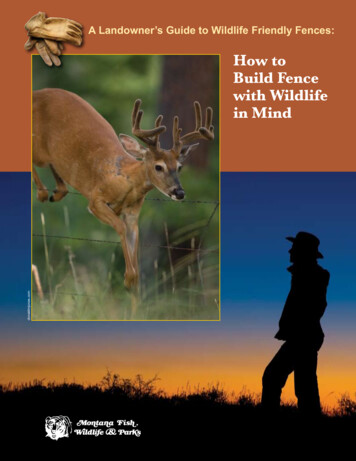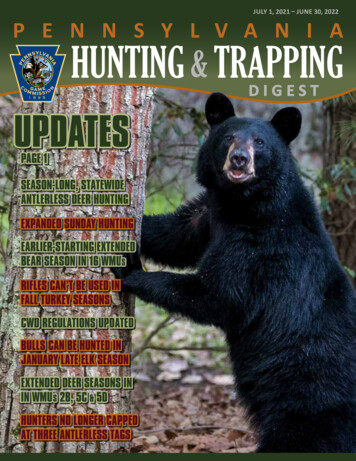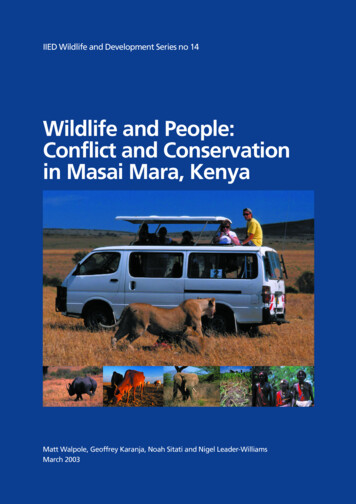
Transcription
IIED Wildlife and Development Series no 14Wildlife and People:Conflict and Conservationin Masai Mara, KenyaMatt Walpole, Geoffrey Karanja, Noah Sitati and Nigel Leader-WilliamsMarch 2003
IIED Wildlife & Development SeriesNo. 14, March 2003Wildlife and People:Conflict and Conservation inMasai Mara, KenyaProceedings of a workshop series organised by theDurrell Institute of Conservation and Ecology,University of Kent, UK,funded by theDarwin Initiative for the Survival of Speciesof the British Government’sDepartment of Environment, Food and Rural Affairs.13 – 16 August 2001Masai Mara National Reserve and adjacent group ranches,Kenya.Walpole, M.J., Karanja, G.G., Sitati, N.W.& Leader-Williams, N.International Institute for Environment and Development3, Endsleigh Street, London WC1H 0DD.Te1: 207 388 2117; Fax: 207 388 2826Email: mailbox@iied.orgWeb site: http://www.iied.org/i
TITLES IN THIS 11No.12No.13Murphree M (1995): The Lesson from Mahenye: Rural Poverty, Democracyand Wildlife Conservation.Thomas S (1995): Share and Share Alike? Equity in CAMPFIRE.Nabane N (1995): A Gender-Sensitive Analysis of CAMPFIRE in MasokaVillage.Thomas S (1995): The Legacy of Dualism in Decision-Making withinCAMPFIRE.Bird C and Metcalf S (1995): Two Views from CAMPFIRE in Zimbabwe’sHurungwe District: Training and Motivation. Who benefits and who doesn’t?Bird C, Clark J, Moyo J, Moyo JM, Nyakuna P and Thomas S (1995): Accessto Timber in Zimbabwe’s Communal Areas.Hasler R (1995): The Multi-Tiered Co-Management of Zimbabwean WildlifeResources.Taylor R (1995): From Liability to Asset: Wildlife in the Omay CommunalLand of Zimbabwe.Leader-Williams N, Kayera JA and Overton GL (eds.) (1996): Mining inProtected Areas in Tanzania.Roe D, Leader-Williams N and Dalal-Clayton B (1997): Take OnlyPhotographs, Leave Only Footprints: The Environmental Impacts of WildlifeTourism.Ashley C and Roe D (1998): Enhancing Community Involvement in WildlifeTourism: Issues and Challenges.Goodwin H, Kent I, Parker K and Walpole M (1998): Tourism, Conservationand Sustainable Development: Case Studies from Asia and Africa.Dalal-Clayton B and Child B (2001) Lessons from Luangwa: The Story of theLuangwa Integrated Resource Development Project, **************************This publicationPublished by: International Institute for Environment and Development (IIED)3, Endsleigh Street, London, WC1H 0DD, UK.Copyright:IIED, London, UK.Citation:Walpole M, Karanja GG, Sitati NW and Leader-Williams N (2003)Wildlife and People: Conflict and Conservation in Masai Mara,Kenya. Wildlife and Development Series No.14, International Institutefor Environment and Development, London.ISSN:ISBN:136186281 84369 416 ********************Note:The views expressed in this publication are those of the authors andworkshop participants and do not necessarily represent those of IIED.ii
FOREWORD“Wildlife and People: Conflict and Conservation in Masai Mara, Kenya” was a threeyear research and training programme based in and around the Masai Mara NationalReserve, Kenya. It was a collaborative programme between the University of Kent,UK and six Kenyan partner institutions; Narok County Council, TransMara CountyCouncil, Moi University, the World Wide Fund for Nature, the Kenya WildlifeService and the Department of Resource Surveys and Remote Sensing. Core fundingfor the programme was provided by the British Government, via the Darwin Initiativefor the Survival of Species. Additional support was received from collaboratingpartners.The purpose of the programme was:to train Kenyans at all levels to undertake monitoring and research into various formsof human-wildlife conflict in the Mara ecosystem, and to use the results of suchresearch to develop recommendations for the management and mitigation of humanwildlife conflict for the benefit of both people and wildlife.The programme has directly supported the research of two Kenyan PhD students andone British postdoctoral researcher. Furthermore, it has contributed to the training oftwo Kenyan MSc students. In addition, eleven community members in TransMaraDistrict were trained in human-elephant conflict monitoring, ten tour drivers weretrained in the use of GPS satellite navigation units to map the routes of their gamedrives, and the Narok County Council rhino surveillance unit received training,support and equipment.A critical element of the programme was to disseminate, discuss and utilise thefindings locally. To that end, a series of workshops took place in Kenya in August2001. Research results were presented at a two-day workshop attended by allstakeholders and held at Dream Camp, Masai Mara National Reserve. This wasfollowed by two additional one-day workshops held with communities in theTransMara District where the human-elephant conflict study had taken place. Theseadditional workshops were held to return the findings of that particular study to thecommunities and authorities most affected by human-elephant conflict, who hadcontributed so much to the project, and who were unable to travel to the widerworkshop held in the Reserve itself.This document comprises the product of this dissemination process. The workinggroups at each of these workshops yielded recommendations, by debate andconsensus, which are reproduced here in their entirety. It is hoped that these will formthe basis of future management of human-wildlife conflict in the Mara ecosystem.iii
ACKNOWLEDGEMENTSA programme of this nature could not take place without the input and support ofcountless individuals and organisations. It would not be possible to mention them allhere, and so we would like to devote a general expression of thanks and gratitude toall those connected with the programme who, in any way, have contributed to itsunqualified success. We would particularly like to thank Holly Dublin, JethroOdanga, Bob Smith, John Watkin and Charles Matankory for their technical andlogistical support throughout.We are grateful to the UK Government’s Department of the Environment, Food andRural Affairs for funding the program under the auspices of the Darwin Initiative forthe Survival of Species (Project no. 162/6/131). Equally, we would like to thank theOffice of the President of Kenya and both Narok and TransMara Country Councils forpermission to conduct research and training in and around Masai Mara NationalReserve. The six project partner organisations in Kenya all contributed greatly to thesuccess of the programme, and their individual contributions are noted elsewhere inthis report. Additional funding and support was provided by The Wellcome Trust,National Geographic, The Wingate Trust, The Mammal Conservation Trust, TheBritish Airways Assisting Conservation Scheme and The German Organisation forTechnical Cooperation (GTZ). The Kenya Agricultural Research Institute (KARI)hosted project staff in TransMara for the duration of the fieldwork. In addition, DreamCamp, Masai Mara, provided an excellent venue and vital logistical support duringthe workshop itself. Izabella Koziell and Dilys Roe at IIED provided editorial supportin the preparation of this report.Finally, we would like to thank all of our colleagues, both staff and students, at theDurrell Institute of Conservation and Ecology (DICE) and the Department ofAnthropology at the University of Kent for their support and encouragementthroughout the programme.AuthorsMatt Walpole is a Research Associate at DICE, and project officer for the DarwinInitiative programme in the Mara ecosystem.Geoffrey Karanja was a PhD student on the Darwin Initiative programme, and iscurrently a lecturer in the Department of Wildlife Management, Moi University,Kenya.Noah Sitati was a PhD student on the Darwin Initiative programme, and is currentlyundertaking further research into human-elephant conflict mitigation in the Maraecosystem for DICE and WWF.Nigel Leader-Williams is the Director of DICE, and project leader of the DarwinInitiative programme.For further details of the programme and its outputs, visit the programme web site(http://www.mosaic-conservation.org). See also the official Darwin Initiative web site(http://www.darwin.gov.uk).v
ACRONYMS AND ASSCTMTMCCWPUWWFAfrican Elephant Specialist Group (of IUCN/SSC)Animal and Habitat ProtectionDistrict CommissionerDigital Elevation ModelDistrict Executive OfficerDurrell Institute of Conservation and EcologyFriends of ConservationGeographical Information SystemGlobal Positioning SystemGerman Organisation for Technical CooperationHuman-Elephant ConflictHuman-Elephant Conflict TaskforceInternational Institute for Environment and DevelopmentWorld Conservation UnionKenya Agricultural Research InstituteKenya Professional Safari Guides AssociationKenya ShillingsKenya Wildlife ServiceMasai Mara Ecological Monitoring ProgrammeMasai Mara National ReserveMid-Zambezi Elephant ProjectNarok County CouncilNormalised Difference Vegetation IndexNon-Governmental OrganisationRapid Rural AppraisalSpecies Survival CommissionTransMara DistrictTransMara County CouncilWildlife Planning UnitWorld Wide Fund for Naturevi
TABLE OF CONTENTSForewordAcknowledgementsAcronyms and AbbreviationsTable of ContentsIntroductioniiivviviiix .Workshop ProceedingsOpening AddressD. Ole Seur1Chairman’s IntroductionN.Leader-Williams3Tourism Impacts in Masai Mara National ReserveG.Karanja5Factors Affecting the Recovery of Masai MaraBlack Rhino PopulationM.J.Walpole17Human-Elephant Conflict in TransMara District, KenyaN.Sitati27Working Group Recommendations39 .Recent UpdatesReferencesList of Workshop Participants515357vii
INTRODUCTIONBiodiversity is facing widespread competition with humanity for space and resources (Pimm et al.,1995; Balmford et al., 2001). As a result, many species are increasingly coming into conflict withpeople, and this is particularly true of large mammals. Some, such as rhinoceroses and large carnivores,bear most of the cost of this conflict and are either critically endangered or declining rapidly(Woodroffe & Ginsberg, 1998; Emslie & Brooks, 1999). Others, such as the African elephant, alsoinflict considerable impacts on people and are in the unusual position of being simultaneously anendangered species (IUCN, 2000) and, in places, a pest species.Protected areas, the cornerstone of modern biodiversity conservation, go some way to protectingspecies (Bruner et al., 2001). However, they do not completely resolve human-wildlife conflicts sincethey do not always exclude destructive human impacts (Liu et al., 2001). Equally, protected areas oftenonly protect a part of an ecosystem or species range, and wildlife dispersal from such areas mayincrease conflict with man (Woodroffe & Ginsberg, 1998). Even as alternative forms of land use, suchas wildlife tourism, are implemented in an attempt to derive sustainable benefits from wildlife, conflictmay remain (Roe et al., 1997; Goodwin et al., 1998).The challenge facing conservationists is to identify strategies to mitigate conflict between wildlife andpeople, be they resident communities or visiting tourists, so that mutually sustainable benefits can bederived for both sides (IUCN/UNEP/WWF, 1980; Boo, 1990). This is an extremely difficult task,requiring a detailed understanding of the issues in each particular case, and careful monitoring andadaptive management on the basis of informed decision-making and consensus among stakeholders.The Serengeti-Mara ecosystem in East Africa embodies many of the current issues in biodiversityconservation (Sinclair & Arcese, 1995). Despite being a vast area incorporating two major protectedareas, its considerable large mammal fauna requires access to large, unprotected dispersal rangesinhabited, and increasingly transformed, by agro-pastoral human communities (Homewood & Rogers,1991; Homewood et al., 2001). Equally, its scenery and wildlife have attracted huge interest from thetourism industry (Gakahu, 1992). As a result, a variety of human-wildlife conflicts are evident bothwithin and around the protected areas of the ecosystem. These conflicts are a significant threat toecosystem viability in general, and large mammal populations in particular (Ottichilo et al., 2000).Against this backdrop, the Durrell Institute of Conservation and Ecology, along with a variety ofKenyan partner organisations, obtained a grant from the Darwin Initiative for the Survival of Species (aBritish Government funding mechanism administered by the Department of Environment, Food andRural Affairs) in 1997. This was to initiate a programme of research, monitoring and local capacitybuilding in human-wildlife conflict and its mitigation in and around Masai Mara National Reserve(MMNR), on the Kenyan side of the Serengeti-Mara ecosystem. The programme focused on three areasof human-wildlife conflict. First, on tourism impacts on wildlife within MMNR. Second, on tourist andlocal community impacts on the endangered black rhinoceros population within MMNR. And finally,on human-elephant conflict outside the Reserve.THE SERENGETI-MARA ECOSYSTEMThe Serengeti-Mara ecosystem is an area of some 25,000 km2 spanning the border between Tanzaniaand Kenya in East Africa (34-36 E, 1-3 30 S). It is commonly defined by the movements of anannual migration of wildebeest from the southern plains of the Serengeti National Park to the northerngrasslands of Masai Mara National Reserve and back (Sinclair & Norton-Griffiths, 1977).The Kenyan part of the ecosystem lies in the south-west of the country in the Rift Valley Province,forming part of two Districts: Narok and TransMara. It comprises approximately 6000 km2, of whichc.25% represents Masai Mara National Reserve and 75% is unprotected land inhabited by Maasai andother agro-pastoral communities.Lying at an altitude of c.1600 m, MMNR is an area of undulating East African woodland/savanna(Taiti, 1973) intersected by numerous drainage lines. It is bisected by the Mara River that forms theix
border between Narok District to the east, and TransMara District to the west (Fig. 1). The extensivegrasslands are dominated by Themeda triandra. Woody vegetation has shown a cyclical pattern overthe past century (Dublin, 1991), and is currently in decline as a result of fire and the pressure of asustained high-density elephant population (Dublin & Douglas-Hamilton, 1987; Dublin et al., 1990). Itis principally limited to riverine forest along the Mara River, thickets dominated by Croton dichogamuson hill slopes and along drainage lines, and some remnant Acacia woodland (Dublin, 1984, 1991;Nabaala, 2000). Mean annual rainfall over the past decade was 950 mm, and normally lies within therange of 800 – 1200 mm, with a northwest to southeast declining gradient. Rainfall is bimodal, with amain dry period from mid-June to mid-October and a shorter dry season during January and February(Stelfox et al., 1986; MMEMP, unpublished data). Maximum daily temperatures lie between 26 and30 C (Burney, 1980).MMNR is unfenced and contiguous with unprotected land to the north, east and west, and the SerengetiNational Park to the south. The characteristic grassland plains extend to the north and east. To the eastand south the area becomes drier, more hilly and bushed, and is bounded by the Loita hills. To thenorth and west, MMNR is bounded by the Siria escarpment, beyond which the land rises to well over2200 m, covered by a mosaic of Afro-montane, semi-deciduous and dry-deciduous forests and Acaciasavanna woodlands (Kiyiapi et al., 1996).MMNR is home to a wide range of mammal, bird, and reptile species. It is especially famous for itsconcentration of migratory herbivores, including approximately 100,000 zebra (Equus burchelli) andover 1 million wildebeest (Connochaetes taurinus), during the dry season from July to October(Maddock, 1979; Sinclair et al., 1985). Thomson’s gazelles (Gazella thomsoni) also migrate, but onlyas far as the edge of the woodlands. This movement of wildebeest and zebra from the Serengeti in thesouth has occurred on a significant scale only since 1972, when wildebeest numbers increased as aresult of the successful control of rinderpest (Stelfox et al., 1986; Dublin et al., 1990). The sight ofhundreds of thousands of these animals moving together through the grasslands has been described bymany popular accounts as one of the greatest wildlife spectacles on earth.MMNR is also famous for its other large mammals. Among these are the so-called “Big Five” whichinclude the cape buffalo (Syncerus caffer), elephant (Loxodonta africana), leopard (Panthera pardus),lion (Panthera leo) and black rhinoceros (Diceros bicornis), as well as a variety of plains game andlarge carnivores (Broten & Said, 1995). The endangered wild dog (Lycaon pictus) remains on theperiphery of the ecosystem (FoC, unpublished data).MMNR was first established as a Wildlife Sanctuary in 1948 (Koikai, 1992). It comprised a smallerarea than the present reserve and included the Mara Triangle, a 520 km area between the SiriaEscarpment, the Tanzanian border and the Mara River. Hunting was regulated in this area. In 1961 theborders were extended east of the river to encompass an area of 1,831 km , converted to a GameReserve and brought under the direct control of Narok County Council (NCC). Some 1,672 km of thisarea was given the status of National Reserve in 1974, under Legal Notice 271 (WPU, 1983). An areaof 159 km that was not gazetted as a national reserve was returned to the local communities. Therewere discussions in 1976 between the Kenyan Government and NCC to further reduce the area by 162km . Following these discussions, sections in the northeast, southeast and the mid-north were excisedthrough formal notice in 1984. These excisions reduced the area of MMNR to its present size of 1,510km . In 1995, the control of MMNR was divided between NCC and TransMara County Council(TMCC) when the latter was formed out of the western part of the former. In May 2001, the MaraTriangle was put under the management of Mara Conservancy, a not-for-profit organisation (Walpole& Leader-Williams, 2001).The surrounding unprotected areas of the ecosystem are a mixture of private and communally ownedland (Homewood et al., 2001). Historically, the area was inhabited by semi-nomadic pastoralist Maasaicommunities (Homewood & Rogers, 1991). Land was held in trust for communities by thegovernment, and some areas in the east of the ecosystem retain this arrangement. From the 1970s, thesetrust lands were converted into group ranches under local administration. More recently, subdivision ofgroup ranches into parcels of privately owned land has been widely promoted (Thompson &Homewood, 2002).The sale of private land, and inward migration by neighbouring agricultural groups, has resulted insignificant land transformation. This is particularly prevalent on the northern and western borders ofx
the ecosystem, where mechanised wheat production and intensive small-scale agriculture, respectively,are spreading (Homewood et al., 2001; Serneels et al., 2001; Sitati, 1997; 2003). These changes may beresponsible for an observed twenty-year decline in resident herbivores on the Kenyan side of theecosystem (Ottichilo et al., 2000, 2001; Homewood et al., 2001, Serneels & Lambin, 2001).KenyaMMNR and TransMaraMaraRiverTransMara DistrictNarok DistrictMusiaraSectorMara TriangleMMNRNKeekorok Sector01020KilometresFigure 1. Map of the study area.xi
OPENING ADDRESSDAVID OLE SEURSenior Warden (Trans Mara),Masai Mara National ReserveMr Chairman, distinguished delegates,First and foremost I would like to take this opportunity to thank the organisers for having invited me toopen this important workshop on the work of the Darwin Initiative programme regarding humanwildlife conflict in and around Masai Mara. I am addressing you today on behalf of both myself, andJames Sindiyo, Senior Warden of the Narok side of Masai Mara National Reserve. Together we arejointly responsible for overseeing the management of the Reserve, and it gives us both great pleasure tosee this programme coming to fruition and to see the results disseminated to so wide an audience ofstakeholders and partners.The Masai Mara National Reserve is a unique resource for the Maasai people, the country of Kenya,and the World in general. Its 1500 square kilometres of grassland savannah are home to an outstandingvariety of wildlife of every description, from the large mammals, to the huge variety of bird life, to themultitude of insect species that pollinate the plants and provide food for those higher in the food chain.This diversity is in turn a result of the huge variety of habitats found in the Mara, from the endlessrolling grassland plains, to the upland thickets and acacia woodlands, to the swamps of Musiara and thetall canopy forest of the Mara river itself.The Masai Mara is quite rightly the jewel in the crown of Kenya’s tourism industry. Where else canone see such a huge number of animals in such variety, so easily? Where else can a visitor have theopportunity of seeing the big five – elephant, rhino, buffalo, lion and leopard – in the space of a fewdays? Watching a cheetah stalk its prey, or experiencing the dawn sunrise from a hot air balloon, arethe highlights of any visit to Africa and are memories that visitors will cherish forever. Moreover, themoney that visitors spend coming to Masai Mara provides vital resources for the Reserve to help uscontinue our conservation efforts, and provides jobs for our people and taxes to support nationaldevelopment. For these reasons, it is vital that we conserve the Mara and all of its biodiversity.One of our most important resources, for both conservation and tourism, is the black rhino populationin Masai Mara. Unlike other areas of the country, we have never lost our rhinos despite dramaticdeclines brought on by poaching. With the assistance of Friends of Conservation, which started out asFriends of Masai Mara, we began a major security and monitoring exercise in the mid 1980s to protectthe remaining rhinos in the Reserve. Through the dedication and hard work of the rhino surveillanceunit, led for many years now by Sergeant Philip Bett, we have seen a gradual recovery of the rhinopopulation from the dark days of poaching. However, as we shall see today, we are still a long wayfrom the good old days of the 1960s and 70s when rhinos numbered over 100 in the Reserve. Conflictbetween people and rhinos, manifested as poaching, caused their great decline in the past. To whatextent is continued conflict, even after the end of poaching, affecting their recovery? We will hear moreabout this today.The rhinos and other wildlife in the Mara are the attractions that bring tourists and their dollars to thisplace. However, tourism may not be completely benign. As with any industry, it is not totally harmlessto the environment, despite our best efforts to ensure that it is as sustainable as possible. With over100,000 visitors a year to the Mara, each staying for two or three days and each covering many miles intheir vehicles in search of wildlife, it is not surprising that negative environmental impacts occur. Asmanagers and custodians of this amazing resource, it is our job to ensure that visitor impacts areminimised, whilst visitor enjoyment is maximised. This will depend on our ability to adequatelyeducate visitors about how they should behave, whilst enforcing the regulations from time to time. Butthe responsibility also lies with visitors and tour drivers to do their best to respect the rules that we haveput in place. We will hear today something of the current impacts of tourism, and to what extent theyare controlled by regulations and law enforcement.1
Masai Mara is rightly regarded as a special and unique place. However, we should not forget that it isonly a very small part of a much larger ecosystem. The Serengeti-Mara ecosystem spans over ten timesthe area of Masai Mara itself, crossing the international border with our neighbours in Tanzania. Whilstmuch of the Tanzanian side of the ecosystem falls within the protected area of the Serengeti NationalPark, the majority of the Kenyan side is Maasai community land rather than government protected area.Seventy-five percent of the Serengeti-Mara ecosystem on the Kenyan side of the border falls withingroup ranches such as Koyiaki-Lemek and Siana. Equally, wildlife within the ecosystem extendsbeyond the escarpment in the west into Maasai land in TransMara district.The survival of Masai Mara, and of the ecosystem as a whole, is vitally dependent upon the coexistenceof local people with wildlife in these dispersal areas. For example, the annual wildebeest migration,which is globally unique and one of the key reasons for the international recognition that thisecosystem receives, would not survive within the boundaries of Masai Mara alone. The wildebeestneed the dispersal areas if they are to survive in such numbers. Equally, other wildlife populationswould crash without seasonal access to resources outside the Reserve.Historically, Maasai communities have coexisted with wildlife in this ecosystem fairly harmoniously. Itis no coincidence that the richest wildlife areas in the country are within Maasai, and related Samburu,areas. However, as communities become more sedentary and change their lifestyles and as populationsincrease, there is an inevitable increase in conflict with wildlife over access to resources. Whereverwildlife and people coexist there will be some form of competition and conflict, and the challenge is tomanage that, to reduce it. It is unlikely that conflict can ever be totally eradicated, but it needs to becontrolled at a level that local people can tolerate, and at the same time people need to see a benefitfrom wildlife to offset those costs of conflict.Besides predators that take cattle and kill people, one of the major conflict species is the elephant.Because of their size they can be very destructive, and pose a threat to people and their crops. All overKenya, where elephant ranges are being constrained, we are seeing an upsurge in conflict with people.This mirrors the situation in other parts of Africa, and is becoming a major concern of the internationalconservation community. In TransMara, where cultivation is increasing dramatically, human-elephantconflict has also increased. We will hear today of studies into this problem, and of efforts to mitigate it.Human-wildlife conflict, in whatever form, be it tourism impacts or conflict with local communities,threatens the very existence of wildlife in the Serengeti-Mara ecosystem. If we lose this resource thenwe lose a vital means of revenue generation in an otherwise marginal environment. And we lose aworld heritage of unending value to us, our children, and to future generations. Those of us chargedwith managing and conserving this vital resource need basic information on patterns, trends andexplanatory factors if we are to do the best we can. For many decades now we have welcomedresearchers to Masai Mara National Reserve, and into the surrounding communities, to help us tocollect the information we need to assist us in our tasks.This workshop brings together the findings of the latest group of researchers to join us here in Mara. Itgives me particular pleasure to welcome them back to tell us of their findings, because all too oftenresearch results get lost in technical reports that sit on shelves and never get read. By bringing all of ustogether to discuss the findings and how we can proceed in light of them, this workshop is addingconsiderably to the value of the research undertaken. I would like to urge all researchers and otherpartners to do their utmost to ensure that the valuable work that they do reaches the ears of those whoneed it most. In the past we have had an annual research forum supported by Friends of Conservation,and occasional workshops to discuss various conservation and development issues, such as thoseorganised by the African Conservation Centre in Koyiaki-Lemek. I believe that this sort of functionshould be much more widely promoted, so that we can all learn from each other and understand eachother better. In this way greater cooperation, understanding and achievement can be nurtured.As a last word I would like to thank the sponsors of this workshop, the Darwin Initiative for theSurvival of Species, which is part of the British Government’s Department of Environment, Food andRural Affairs, and also the organisers of the workshop: the Durrell Institute of Conservation andEcology from the University of Kent, UK.Mr Chairman, distinguished delegates, I wish us every success in our deliberations, and I now formallydeclare this workshop open.2
CHAIRMAN’S INTRODUCTIONNIGEL LEADER-WILLIAMSDurrell Institute of Conservation and Ecology,University of KentLadies and gentlemen,I would like to thank the distinguished speaker for opening this workshop. As chairman and facilitator,it is my role to ensure that the proceedings run smoothly and to time. I will do my best to ensure thatwe get the most that we can out of the time we are all devoting to this exercise.First, however, I want to say a few words about the Darwin Initiative programme and about thisworkshop and what we hope to achieve. Four years ago, the Durrell Institute of Conservation andEcology at the University of Kent received funding from the British Government, under theirbiodiversity funding body the Darwin Initiative for the Survival of Species, to undertake research andtraining in human-wildlife conflict in and around Masai Mara National Reserve. This project cameabout through extensive discussions with KWS, WWF and Moi University, and meetings withrepresentatives from both C
adaptive management on the basis of informed decision-making and consensus among stakeholders. The Serengeti-Mara ecosystem in East Africa embodies many of the current issues in biodiversity conservation (Sinclair & Arcese, 1995). Despite being a vast area incorporating two major protected areas, its considerable large mammal fauna requires access to large, unprotected dispersal ranges .
